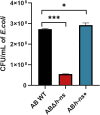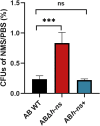The Negative Regulatory Role of Transcriptional Regulator H-NS on the Type VI Secretion System in Acinetobacter baumannii
- PMID: 40529232
- PMCID: PMC12170815
- DOI: 10.2147/IDR.S512650
The Negative Regulatory Role of Transcriptional Regulator H-NS on the Type VI Secretion System in Acinetobacter baumannii
Abstract
Introduction: This study investigates the negative regulatory role of the global transcriptional regulator H-NS (Histone-like Nucleoid Structuring Protein) on the Type VI secretion system (T6SS) in Acinetobacter baumannii (A. baumannii). We explored potential targets of H-NS mediated silencing or activation within the regulation of A. baumannii T6SS, along with the specific regulatory mechanisms involved, thereby providing a theoretical foundation for further research on A. baumannii invasive infections stemming from mixed infections and the development of therapeutic target.
Methods: Using the plasmids pAT04 and pYMAb2-hyg, we constructed A. baumannii ATCC19606 strains with the hns gene knocked out (ABΔhns) and overexpressed (ABhns+). We measured the expression of the T6SS-related gene hcp in wild-type (AB WT), ABΔhns, and ABhns+ strains using RT-qPCR, combined with a mouse sepsis model featuring mixed infections. We assessed their serum resistance, competitive ability against Escherichia coli (E. coli), and blood invasion capability. Proteomic analysis identified differentially expressed proteins, and we further investigated the regulatory role of H-NS on A. baumannii T6SS using electrophoretic mobility shift assays (EMSA).
Results: We successfully constructed both ABΔhns and ABhns+ strains of A. baumannii ATCC19606. RT-qPCR results indicated that H-NS functions as a negative regulator of the T6SS-related gene hcp in A. baumannii. Phenotypic assays for extracellular virulence revealed that the loss of hns enhanced both the competitive ability and serum resistance of ATCC19606. Results from the mouse sepsis infection model demonstrated that knockout of hns significantly increased the bacterium's blood invasion capability. Bioinformatics analysis of differentially expressed proteins identified elevated levels of T6SS-related proteins in the knockout strain. Furthermore, EMSAs confirmed that H-NS directly binds to multiple sites in the upstream region of hcp.
Conclusion: H-NS inhibits the expression of T6SS-related proteins in A. baumannii by regulating relevant targets associated with the T6SS. This regulation influences the bacterium's pathogenicity, interspecies competitive ability, and serum resistance.
Keywords: Acinetobacter baumannii; H-NS; mixed infection; septicemia; type VI secretion system.
© 2025 Zhang et al.
Conflict of interest statement
The authors report no conflicts of interest in this work.
Figures









Similar articles
-
Establishment and Comparison of Fluorescence-Based T6SS Activity Detection Methods in Acinetobacter baumannii.J Vis Exp. 2025 Jun 20;(220). doi: 10.3791/67772. J Vis Exp. 2025. PMID: 40622873
-
Structural and mechanistic insights into the transcriptional regulation of chromosomal T6SS by large conjugative plasmid-encoded TetRs in Acinetobacter baumannii.Nucleic Acids Res. 2025 Jul 19;53(14):gkaf755. doi: 10.1093/nar/gkaf755. Nucleic Acids Res. 2025. PMID: 40794870
-
Characterizing the interplay between Acinetobacter baumannii, A549 cells, and anti-Omp34 antibodies: implications for adherence, internalization, and cytotoxicity.Folia Microbiol (Praha). 2025 Jun;70(3):699-709. doi: 10.1007/s12223-024-01218-4. Epub 2024 Oct 31. Folia Microbiol (Praha). 2025. PMID: 39480642
-
Unveiling the role of adhesin proteins in controlling Acinetobacter baumannii infections: a systematic review.Infect Immun. 2025 Feb 18;93(2):e0034824. doi: 10.1128/iai.00348-24. Epub 2025 Jan 8. Infect Immun. 2025. PMID: 39772848 Free PMC article.
-
Assessing the comparative effects of interventions in COPD: a tutorial on network meta-analysis for clinicians.Respir Res. 2024 Dec 21;25(1):438. doi: 10.1186/s12931-024-03056-x. Respir Res. 2024. PMID: 39709425 Free PMC article. Review.
References
LinkOut - more resources
Full Text Sources
Miscellaneous

